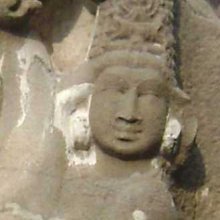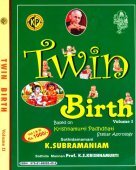Sarpa, Sārpa: 34 definitions
Introduction:
Sarpa means something in Buddhism, Pali, Hinduism, Sanskrit, Jainism, Prakrit, the history of ancient India, Marathi, Hindi, biology. If you want to know the exact meaning, history, etymology or English translation of this term then check out the descriptions on this page. Add your comment or reference to a book if you want to contribute to this summary article.
Images (photo gallery)
(+5 more images available)
In Hinduism
Purana and Itihasa (epic history)
Source: Wisdom Library: The Agni PuranaSarpa (सर्प):—One of the Eleven Rudras (ekādaśa-rudra), according to the Agni-purāṇa. The Agni Purāṇa is a religious text containing details on Viṣṇu’s different incarnations (avatar), but also deals with various cultural subjects such as Cosmology, Grammar and Astrology.
Source: archive.org: Puranic EncyclopediaSarpa (सर्प).—A son of Tvaṣṭā. According to Agni Purāṇa the sons of Tvaṣṭā were called Ekādaśarudras; But according to Mahābhārata, Sarpa, one of the Ekādaśarudras is the son of Sthāṇu and the great-grandson of Brahmā. (Ādi Parva, Chapter 66, Verse 2).
Source: archive.org: Shiva Purana - English TranslationSarpa (सर्प) refers to “snakes”, according to the Śivapurāṇa 2.3.27 (“Description of the fraudulent words of the Brahmacārin”).—Accordingly, as Śiva (in guise of a Brahmacārin) said to Pārvatī: “[...] I know Śiva through and through with all His weighty attributes. I shall tell you the truth. Listen with attention. [...] He holds the skull. Serpents twine [i.e., sarpa-augha] round His limbs. Poison has left a mark on his neck. He eats even forbidden stuffs. He has odd eyes and is definitely awful. His birth and pedigree cannot be traced. He is devoid of the enjoyment of a householder. He has ten arms. He is mostly naked and is ever accompanied by ghosts and goblins. [...]”.
Source: Cologne Digital Sanskrit Dictionaries: The Purana Index1a) Sarpa (सर्प).—A Rākṣasa with the sun in nabhonabha months; a son of Yātudhāna.*
- * Brahmāṇḍa-purāṇa II. 23. 11; III. 3. 70; 7. 90; Vāyu-purāṇa 69. 128.
1b) A son of Brahmadhāna.*
- * Brahmāṇḍa-purāṇa III. 7. 98; Vāyu-purāṇa 69. 133.
1c) To be worshipped in house-building.*
- * Matsya-purāṇa 253. 27.
1d) One of the eleven Rudras.*
- * Vāyu-purāṇa 66. 69.
1e) A class of Rākṣasas sprung from Sarpa; also Pannagas.*
- * Brahmāṇḍa-purāṇa II. 32. 1; 35. 191; III. 7. 97; 8. 70.
1f) Snakes whose overlord is Takṣaka;1 moving creatures, sarīsṛpās.2
2) Sārpa (सार्प).—One of the eight muhūrtas of the afternoon.*
- * Brahmāṇḍa-purāṇa III. 3. 39.
Sarpa (सर्प) refers to “snakes” (dwelling in rivers in the forest), according to the Rāmāyaṇa chapter 2.28. Accordingly:—“[...] soothening with kind words to Sītā, when eyes were blemished with tears, the virtuous Rāma spoke again as follows, for the purpose of waking her turn back: ‘[...] Snakes (sarpa) dwelling in rivers, moving crookedly like rivers, stay obstructing the pathways. Hence, living in forest is a great misery’”.

The Purana (पुराण, purāṇas) refers to Sanskrit literature preserving ancient India’s vast cultural history, including historical legends, religious ceremonies, various arts and sciences. The eighteen mahapuranas total over 400,000 shlokas (metrical couplets) and date to at least several centuries BCE.
Shilpashastra (iconography)
Source: Red Zambala: Hindu Icons and Symbols | IntroductionSarpa (Snakes) - Kundalini - sexual energy latent within the lowest chakra – the Mūlādhāra at the base of the spine. Also symbolizes the control of anger the worst of all the negative emotions.

Shilpashastra (शिल्पशास्त्र, śilpaśāstra) represents the ancient Indian science (shastra) of creative arts (shilpa) such as sculpture, iconography and painting. Closely related to Vastushastra (architecture), they often share the same literature.
Chandas (prosody, study of Sanskrit metres)
Source: Shodhganga: a concise history of Sanskrit Chanda literatureSarpa (सर्प) refers to one of the 23 types of dohā metres (a part of mātrā type) described in the 1st chapter of the Vṛttamauktika by Candraśekhara (17th century): author of many metrical compositions and the son of Lakṣmīnātha Bhaṭṭa and Lopāmudrā.

Chandas (छन्दस्) refers to Sanskrit prosody and represents one of the six Vedangas (auxiliary disciplines belonging to the study of the Vedas). The science of prosody (chandas-shastra) focusses on the study of the poetic meters such as the commonly known twenty-six metres mentioned by Pingalas.
Ayurveda (science of life)
Veterinary Medicine (The study and treatment of Animals)
Source: archive.org: The Elephant Lore of the HindusSarpa (सर्प) or Sarpasattva refers to the “Serpent-like character” (of certain elephants), according to the 15th century Mātaṅgalīlā composed by Nīlakaṇṭha in 263 Sanskrit verses, dealing with elephantology in ancient India, focusing on the science of management and treatment of elephants.—[Cf. chapter 8, “on marks of character”]: “13. Betraying trust, cruel, crooked-stepping in gait, who does not eat very much when in must, such an elephant is considered a serpent in character (sarpa-sattva)”.
Unclassified Ayurveda definitions
Source: gurumukhi.ru: Ayurveda glossary of termsSarpā (सर्पा):—[sarpāḥ] Snakes.

Āyurveda (आयुर्वेद, ayurveda) is a branch of Indian science dealing with medicine, herbalism, taxology, anatomy, surgery, alchemy and related topics. Traditional practice of Āyurveda in ancient India dates back to at least the first millenium BC. Literature is commonly written in Sanskrit using various poetic metres.
Shaktism (Shakta philosophy)
Source: Google Books: ManthanabhairavatantramSarpa (सर्प) refers to “snakes”, according to the Manthānabhairavatantra, a vast sprawling work that belongs to a corpus of Tantric texts concerned with the worship of the goddess Kubjikā.—Accordingly, “[...] His body is adorned on the left (by his consort) and he is adorned with a garland of wild flowers. He wears earrings made of snakes [i.e., sarpa-kuṇḍala-lambana] and his sacred thread is Vāsuki. The Lord is adorned with tinkling anklets and sits on a ghost in the lotus posture. He is adorned with the five insignia and a garland of severed heads that hangs from his neck up to his feet. He dances with the bliss of wine and is accompanied by heroes and Bhairavas. Sixty-four Yoginīs and great mothers encompass him. He is endowed with sixty-four energies and adorned with ghosts and demons. O Śambhu, Bhairava is said to have as his seat (āsana) the Supreme Goddess”.

Shakta (शाक्त, śākta) or Shaktism (śāktism) represents a tradition of Hinduism where the Goddess (Devi) is revered and worshipped. Shakta literature includes a range of scriptures, including various Agamas and Tantras, although its roots may be traced back to the Vedas.
Jyotisha (astronomy and astrology)
Source: Wisdom Library: Brihat Samhita by VarahamihiraSārpa (सार्प) refers to Āśleṣā, according to the Bṛhatsaṃhitā (chapter 8), an encyclopedic Sanskrit work written by Varāhamihira mainly focusing on the science of ancient Indian astronomy astronomy (Jyotiṣa).—Accordingly, “The Nakṣatras—Rohiṇī and Kṛttikā, form the body of the Vatsara Puruṣa, the two Āṣāḍhas form his navel, Āśleṣā [i.e., sārpa] forms the heart and Maghā, the heart-bladder; when benefíc planets pass through these, there will be happiness in the land; if malefic planets should pass through the body, there will be suffering from fire and winds; if they should pass through the navel, there will be suffering from starvation; if they should pass through the heart-bladder, roots and fruits will suffer, and if they should pass through the heart, crops will perish”.

Jyotisha (ज्योतिष, jyotiṣa or jyotish) refers to ‘astronomy’ or “Vedic astrology” and represents the fifth of the six Vedangas (additional sciences to be studied along with the Vedas). Jyotisha concerns itself with the study and prediction of the movements of celestial bodies, in order to calculate the auspicious time for rituals and ceremonies.
Ganitashastra (Mathematics and Algebra)
Source: archive.org: Hindu MathematicsSarpa (सर्प) represents the number 8 (eight) in the “word-numeral system” (bhūtasaṃkhyā), which was used in Sanskrit texts dealing with astronomy, mathematics, metrics, as well as in the dates of inscriptions and manuscripts in ancient Indian literature.—A system of expressing numbers by means of words arranged as in the place-value notation was developed and perfected in India in the early centuries of the Christian era. In this system the numerals [e.g., 8—sarpa] are expressed by names of things, beings or concepts, which, naturally or in accordance with the teaching of the Śāstras, connote numbers.

Ganita (गणित) or Ganitashastra refers to the ancient Indian science of mathematics, algebra, number theory, arithmetic, etc. Closely allied with astronomy, both were commonly taught and studied in universities, even since the 1st millennium BCE. Ganita-shastra also includes ritualistic math-books such as the Shulba-sutras.
Shaivism (Shaiva philosophy)
Source: SOAS University of London: Protective Rites in the Netra TantraSarpa (सर्प) refers to a “snake”, according to the Netratantra of Kṣemarāja: a Śaiva text from the 9th century in which Śiva (Bhairava) teaches Pārvatī topics such as metaphysics, cosmology, and soteriology.—Accordingly, [verse 11.1-24ab, while describing the appearance and worship of Tumburu]—“[...] [He worships] Deva as Tumburu in the middle of an eight petaled lotus, in the maṇḍala, [starting] in the East, O Devī. [...] He [has] a half-moon in his topknot, sits in the blue lotus Āsana. [Tumburu is] white like a drop of frosty jasmine, similar to mountain snow. [He wears] a serpent as a sacred thread and is adorned with snake ornaments (sarpa-bhūṣaṇa-bhūṣita). [Tumburu is] adorned with all jewels, a tiger skin on the ground [below his] hips, a garment of elephant skin, mounted on a very strong bull, and wears a rhino hide. [...]”.

Shaiva (शैव, śaiva) or Shaivism (śaivism) represents a tradition of Hinduism worshiping Shiva as the supreme being. Closely related to Shaktism, Shaiva literature includes a range of scriptures, including Tantras, while the root of this tradition may be traced back to the ancient Vedas.
Pancaratra (worship of Nārāyaṇa)
Source: archive.org: Catalogue of Pancaratra Agama TextsSarpa (सर्प) or Sarpamudrā refers to one of the 81 Mudrās (hand-gestures) described in chapter 2 of the Ṛṣirātra section of the Sanatkumārasaṃhitā: an encyclopedic Sanskrit text written in over 3500 verses dealing with a variety of topics such as yoga, temple-building, consecration ceremonies, initiation and dhanurveda (martial arts).—[Cf. the chapter mudrā-lakṣaṇa].

Pancaratra (पाञ्चरात्र, pāñcarātra) represents a tradition of Hinduism where Narayana is revered and worshipped. Closeley related to Vaishnavism, the Pancaratra literature includes various Agamas and tantras incorporating many Vaishnava philosophies.
General definition (in Hinduism)
Source: archive.org: Vedic index of Names and SubjectsSarpa (सर्प, ‘serpent’) occurs once in the Rigveda, where Ahi is the usual word, but often later.
In Buddhism
Mahayana (major branch of Buddhism)
Source: Wisdom Library: Maha Prajnaparamita SastraSarpa (सर्प) refers to “(the outer suffering of) the snake”, as mentioned in the 2nd century Mahāprajñāpāramitāśāstra chapter XXXI in the section called “four foundations of mindfulness (smṛtyupasthāna)”.—Accordingly:—“[...] there are two kinds of suffering (duḥkha): inner suffering and outer suffering. [...] Outer suffering (bāhyaduḥkha) is of two types: i) the king (rājan), the victorious enemy (vijetṛ), the wicked thief (caura), the lion (siṃha), tiger (vyāghra), wolf (vṛka), snake (sarpa) and other nuisances (viheṭhana); ii) the wind (vāta), rain (vṛṣṭi), cold (śīta), heat (uṣna), thunder (meghagarjita), lightning (vidyut), thunderbolts, etc: these two kinds of suffering are outer suffering”.
Source: De Gruyter: A Buddhist Ritual Manual on AgricultureSarpa (सर्प) refers to “snakes” (causing crop destruction), according to the Vajratuṇḍasamayakalparāja, an ancient Buddhist ritual manual on agriculture from the 5th-century (or earlier), containing various instructions for the Sangha to provide agriculture-related services to laypeople including rain-making, weather control and crop protection.—Accordingly, [As the Bhagavān teaches an offering manual]: “[...] All crops, all flowers and fruits will be well protected. [...] All pests will be destroyed. Snakes (sarpa), mice, mongooses, porcupines, goats, frogs, stinging insects, mosquitos, locusts and so on, flocks of birds will perish. All worms will be destroyed. Furthermore, flying insects and so on do not occur. They are never able to destroy. [...]”.

Mahayana (महायान, mahāyāna) is a major branch of Buddhism focusing on the path of a Bodhisattva (spiritual aspirants/ enlightened beings). Extant literature is vast and primarely composed in the Sanskrit language. There are many sūtras of which some of the earliest are the various Prajñāpāramitā sūtras.
Tibetan Buddhism (Vajrayana or tantric Buddhism)
Source: OSU Press: Cakrasamvara SamadhiSarpa (सर्प) refers to a “serpent”, according to the Guru-maṇḍala-arcana [i.e., “Guru Mandala Worship]” ritual often performed in combination with the Cakrasaṃvara Samādhi, which refers to the primary pūjā and sādhanā practice of Newah Mahāyāna-Vajrayāna Buddhists in Nepal.—Accordingly, “Oṃ eat eat to the hanging garland of greasy bloody entrails, to Surābhakṣī Hūṃ Phaṭ Svāhā! Oṃ seize seize the snake or serpent (sarpa) come forth from the seven underworlds Hūṃ Phaṭ Svāhā”.

Tibetan Buddhism includes schools such as Nyingma, Kadampa, Kagyu and Gelug. Their primary canon of literature is divided in two broad categories: The Kangyur, which consists of Buddha’s words, and the Tengyur, which includes commentaries from various sources. Esotericism and tantra techniques (vajrayāna) are collected indepently.
In Jainism
General definition (in Jainism)
Source: archive.org: TrisastisalakapurusacaritraSarpa (सर्प) is the name of a magic weapon employed by Rāvaṇa against King Vālin, according to the Jain Ramayana and chapter 7.2 [Rāvaṇa’s expedition of conquest] of Hemacandra’s 11th century Triṣaṣṭiśalākāpuruṣacaritra: an ancient Sanskrit epic poem narrating the history and legends of sixty-three illustrious persons in Jainism.
Accordingly, “Thus enlightened by him, Daśāsya [i.e., Rāvaṇa], knowing dharma, began to fight in person, skilled in all weapons. Whatever weapon Daśagrīva hurled, the king of the Kapis destroyed it by his own weapons, like the sun the brilliance of strong fires. Rāvaṇa even discharged his magic missiles, Sarpa, Varuṇa, etc, and Vālin destroyed them by his missiles, Tārkṣya, etc. Then Daśamukha, angered by the failure of his weapons and magic missiles, drew his sword Candrahāsa, cruel as a great serpent. [...]”.

Jainism is an Indian religion of Dharma whose doctrine revolves around harmlessness (ahimsa) towards every living being. The two major branches (Digambara and Svetambara) of Jainism stimulate self-control (or, shramana, ‘self-reliance’) and spiritual development through a path of peace for the soul to progess to the ultimate goal.
India history and geography
Source: Cologne Digital Sanskrit Dictionaries: Indian Epigraphical GlossarySarpa.—(IE 7-1-2), ‘eight’. Note: sarpa is defined in the “Indian epigraphical glossary” as it can be found on ancient inscriptions commonly written in Sanskrit, Prakrit or Dravidian languages.

The history of India traces the identification of countries, villages, towns and other regions of India, as well as mythology, zoology, royal dynasties, rulers, tribes, local festivities and traditions and regional languages. Ancient India enjoyed religious freedom and encourages the path of Dharma, a concept common to Buddhism, Hinduism, and Jainism.
Biology (plants and animals)
Source: Google Books: CRC World Dictionary (Regional names)Sarpa in India is the name of a plant defined with Arisaema tortuosum in various botanical sources. This page contains potential references in Ayurveda, modern medicine, and other folk traditions or local practices It has the synonym Arum curvatum Roxb. (among others).
Example references for further research on medicinal uses or toxicity (see latin names for full list):
· Flora of the Presidency of Madras
· Monographiae Phanerogamarum (1879)
· Flora (1831)
· Synopsis Aroidearum
· Research Bulletin
· Bonplandia (Hannover) (1859)
If you are looking for specific details regarding Sarpa, for example chemical composition, health benefits, pregnancy safety, diet and recipes, extract dosage, side effects, have a look at these references.

This sections includes definitions from the five kingdoms of living things: Animals, Plants, Fungi, Protists and Monera. It will include both the official binomial nomenclature (scientific names usually in Latin) as well as regional spellings and variants.
Languages of India and abroad
Marathi-English dictionary
Source: DDSA: The Molesworth Marathi and English Dictionarysarpa (सर्प).—m (S) A serpent or snake. The word is, in the Konkaṇ, applied exclusively to the Coluber Naga or Cobra de capello, in the Desh, to every reptile of the serpent-tribe excepting the Coluber Naga, which bears its specific name nāga. See and apply to this word sarpa the notice afforded under its derivative sāpa; adding only that the word sarpa (preserving its majesty as Sanskrit) occurs to be used upon rather extraordinary occasions, as conveying, more forcibly than the Prakrit sāpa, the idea of magnitude or formidableness.
--- OR ---
sārpa (सार्प).—a S Relating to a serpent, serpentine.
Source: DDSA: The Aryabhusan school dictionary, Marathi-Englishsarpa (सर्प).—m A snake, a serpent.
Marathi is an Indo-European language having over 70 million native speakers people in (predominantly) Maharashtra India. Marathi, like many other Indo-Aryan languages, evolved from early forms of Prakrit, which itself is a subset of Sanskrit, one of the most ancient languages of the world.
Sanskrit dictionary
Source: DDSA: The practical Sanskrit-English dictionarySarpa (सर्प).—[sṛp-ghañ]
1) Serpentine or winding motion, gliding.
2) Flowing, going.
3) A snake, serpent.
4) Name of a tree (nāgakeśara).
5) The Āśleṣā constellation.
6) Name of a tribe of Mlechchhas or barbarians.
Derivable forms: sarpaḥ (सर्पः).
--- OR ---
Sārpa (सार्प).—Name of the constellation Āślesā; सार्पे जातौ तु सौमित्री कुलीरेऽभ्युदिते रवौ (sārpe jātau tu saumitrī kulīre'bhyudite ravau) Rām.1.18.15.
Derivable forms: sārpaḥ (सार्पः).
See also (synonyms): sārpya.
Source: Cologne Digital Sanskrit Dictionaries: Shabda-Sagara Sanskrit-English DictionarySarpa (सर्प).—m.
(-rpaḥ) 1. A snake, a serpent. 2. Gentle or twining motion, gliding, flowing, creeping. f. (-rpī) The female of the snake. E. sṛp to go, to glide, aff. ac .
--- OR ---
Sārpa (सार्प).—mfn.
(-rpaḥ-rpī-rpaṃ) Relating to a snake. f. (-rpī) The ninth lunar asterism, of which the serpents (Aślesha) are the presiding deities. E. sarpa a snake, and aṇ aff.; also read sārpya .
Source: Cologne Digital Sanskrit Dictionaries: Benfey Sanskrit-English DictionarySarpa (सर्प).—i. e. sṛp + a, I. m. 1. Sliding motion. 2. A snake, [Mānavadharmaśāstra] 1, 37; [Pañcatantra] iii. [distich] 46. Ii. f. pī, The female of the snake.
Source: Cologne Digital Sanskrit Dictionaries: Cappeller Sanskrit-English DictionarySarpa (सर्प).—[feminine] ī crawling, creeping. [masculine] & [feminine] sarpī snake, adder, a serpent-demon.
--- OR ---
Sārpa (सार्प).—[adjective] relating to serpents; [neuter] [Epithet] of a lunar mansion.
Source: Cologne Digital Sanskrit Dictionaries: Monier-Williams Sanskrit-English Dictionary1) Sarpa (सर्प):—a mf(ī)n. creeping, crawling, stealing along, [Gautama-dharma-śāstra] (cf. pīṭha-, vṛkṣa-s)
2) m. (ifc. f(ā). ) a snake, serpent, serpent-demon (cf. nāga; sarpāṇām ayanam, ‘a [particular] annual festival’), tortuous motion, [Ṛg-veda] etc. etc.
3) m. a [particular] constellation (when only the three unfavourable planets are situated in the three Kendras), [Varāha-mihira’s Bṛhat-saṃhitā]
4) Mesua Roxburghii, [cf. Lexicographers, esp. such as amarasiṃha, halāyudha, hemacandra, etc.]
5) Name of one of the 11 Rudras, [Mahābhārata] of a Rākṣasa, [Viṣṇu-purāṇa]
6) ([plural]) Name of a [particular] tribe of Mlecchas (formerly Kṣatriyas and described as wearing beards), [Harivaṃśa]
7) n. = sapa-sāman q.v.
8) cf. [Greek] ἑρπετόν [Latin] serpens; See also under √srip.
9) Sārpa (सार्प):—mfn. ([from] sarpa, of which it is also the Vṛddhi form in [compound]) relating to snakes or serpents
10) n. (with or [scilicet] bha) Name of the Nakṣatra Ārṣa, [Varāha-mihira’s Bṛhat-saṃhitā; Rāmāyaṇa etc.]
11) Sarpa (सर्प):—[from sṛp] b etc. See p. 1184, col. 1.
Source: Cologne Digital Sanskrit Dictionaries: Yates Sanskrit-English DictionarySarpa (सर्प):—(rpaḥ) 1. m. A snake; gliding motion. f. (ī) Idem.
Source: DDSA: Paia-sadda-mahannavo; a comprehensive Prakrit Hindi dictionary (S)Sarpa (सर्प) in the Sanskrit language is related to the Prakrit word: Sappa.
[Sanskrit to German]
Sanskrit, also spelled संस्कृतम् (saṃskṛtam), is an ancient language of India commonly seen as the grandmother of the Indo-European language family (even English!). Closely allied with Prakrit and Pali, Sanskrit is more exhaustive in both grammar and terms and has the most extensive collection of literature in the world, greatly surpassing its sister-languages Greek and Latin.
Hindi dictionary
Source: DDSA: A practical Hindi-English dictionarySarpa (सर्प) [Also spelled sarp]:—(nm) a serpent, snake; ~[daṃśa] snake-bite; -[nirmāka] the slough (of a snake); -[phaṇa] the hood of a snake; ~[rāja] Vasuki —the mythological serpent king; a huge snake; -[vidyā] the art of snake charming; hence [sarpiṇī] (nf).
...
Kannada-English dictionary
Source: Alar: Kannada-English corpusSarpa (ಸರ್ಪ):—
1) [noun] a moving in a zig-zag manner by crawling on the ground (as a snake does).
2) [noun] a flowing of or as of a liquid.
3) [noun] a snake, esp. a large one; a serpent.
4) [noun] the tree Mesua ferra of Guttiferae family; serpent champaka.
5) [noun] (myth.) name of one of the hells.
6) [noun] (astrol.) the long southern constellation; Epsilon Hydra.
Kannada is a Dravidian language (as opposed to the Indo-European language family) mainly spoken in the southwestern region of India.
Nepali dictionary
Source: unoes: Nepali-English DictionarySarpa (सर्प):—n. a snake;
Nepali is the primary language of the Nepalese people counting almost 20 million native speakers. The country of Nepal is situated in the Himalaya mountain range to the north of India.
See also (Relevant definitions)
Starts with (+18): Sarpabala, Sarpabali, Sarpabana, Sarpabandha, Sarpabhrita, Sarpabhuj, Sarpabhukku, Sarpabhushana, Sarpacchattra, Sarpacchattraka, Sarpachatra, Sarpadamani, Sarpadamsha, Sarpadamshtra, Sarpadamshtri, Sarpadamshtrika, Sarpadanda, Sarpadandi, Sarpadani, Sarpadanti.
Query error!
Full-text (+557): Krishnasarpa, Sarparaja, Visarpa, Kalasarpa, Sarpari, Parisarpa, Samsarpa, Sarpagandha, Sarpasana, Rajasarpa, Sarpamani, Apasarpa, Sarparati, Anusamsarpam, Brahmasarpa, Sarpavidya, Pithasarpa, Avasarpa, Sarparajni, Sarpakshi.
Relevant text
Search found 122 books and stories containing Sarpa, Sārpa, Sarpā, Sarpa's, Sarpan, Sarpas; (plurals include: Sarpas, Sārpas, Sarpās, Sarpa'ses, Sarpans, Sarpases). You can also click to the full overview containing English textual excerpts. Below are direct links for the most relevant articles:
Garga Samhita (English) (by Danavir Goswami)
Verse 2.12.12 < [Chapter 12 - Subduing Kāliya and Drinking the Forest Fire]
Verse 2.14.12 < [Chapter 14 - Description of Kāliya’s Story]
Verse 2.12.11 < [Chapter 12 - Subduing Kāliya and Drinking the Forest Fire]
Rudra-Shiva concept (Study) (by Maumita Bhattacharjee)
42. Number of Rudra < [Chapter 5 - Rudra-Śiva in the Purāṇic Literature]
Kavyamimamsa of Rajasekhara (Study) (by Debabrata Barai)
Part 7.19 - Poetic conventions regarding to the Nāga and Sarpa < [Chapter 5 - Analyasis and Interpretations of the Kāvyamīmāṃsā]
Part 7.3 - Classifications of Kavisamaya (poetic conventions) < [Chapter 5 - Analyasis and Interpretations of the Kāvyamīmāṃsā]
Chandogya Upanishad (english Translation) (by Swami Lokeswarananda)
Brihat Jataka by Varahamihira [Sanskrit/English] (by Michael D Neely)
Verse 5.3 < [Chapter 5 - Birth Matters]
Verse 11.2 < [Chapter 12 - Nabhasa Yogas]
Verse 27.22 < [Chapter 28 - Conclusion]
Rig Veda (translation and commentary) (by H. H. Wilson)
Related products






